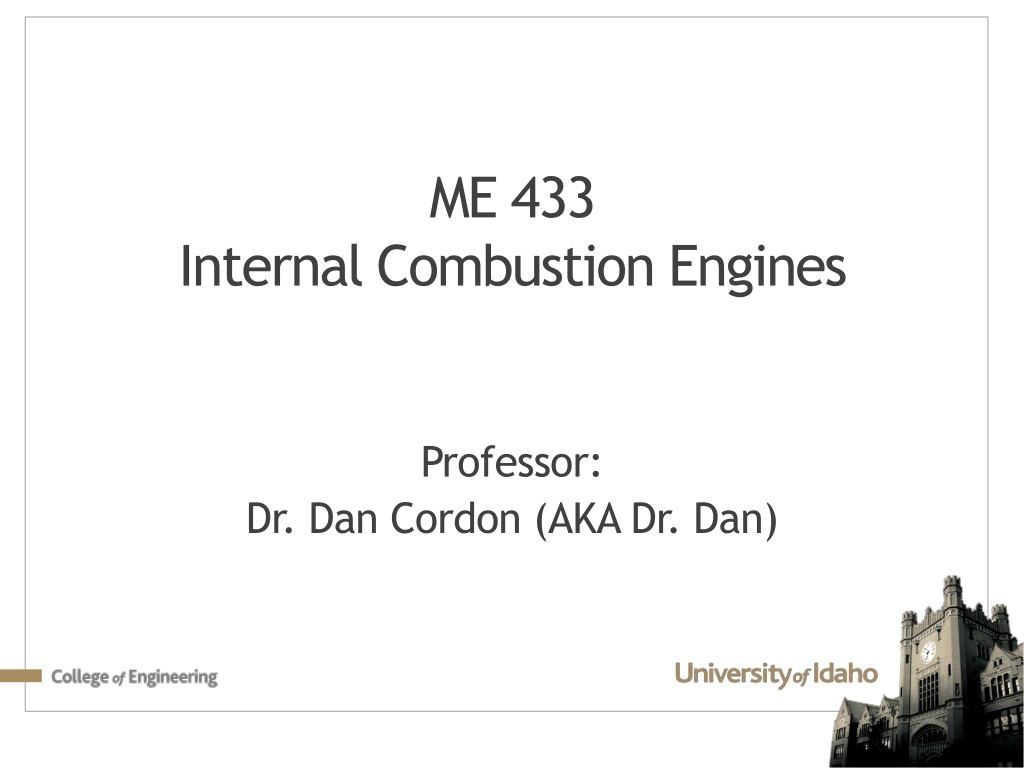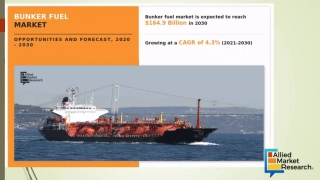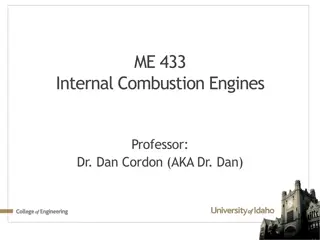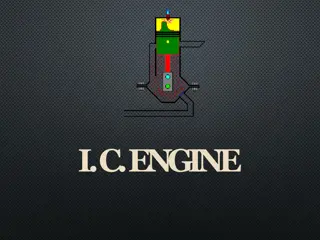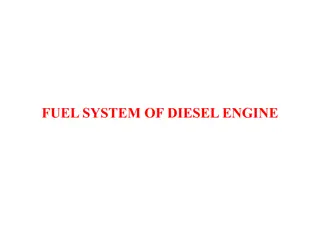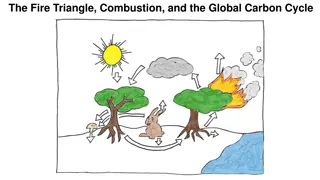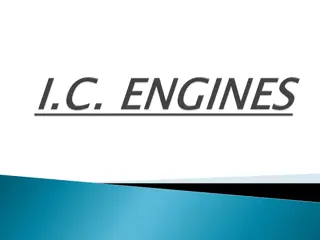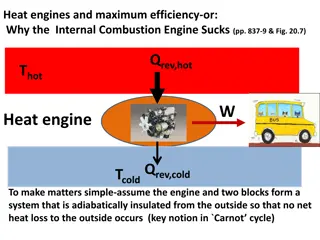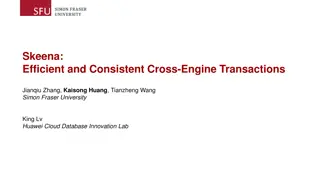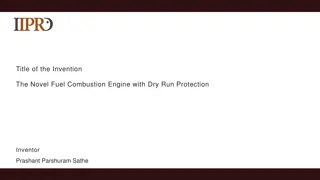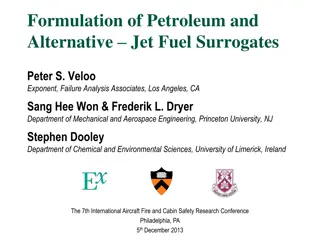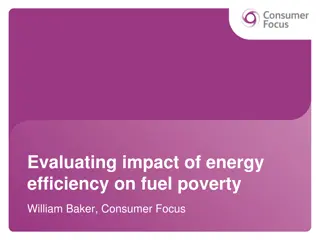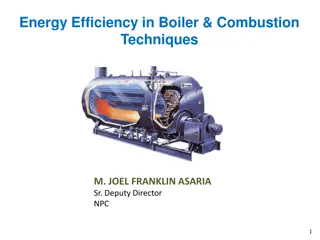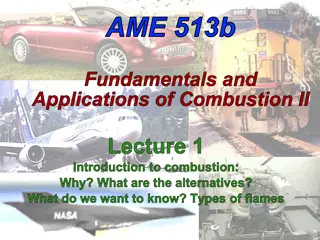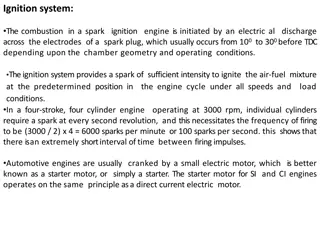Understanding Fuel Chemistry in Internal Combustion Engines
Fuel chemistry knowledge is crucial for internal combustion engines for various reasons such as determining air-fuel ratios, ensuring efficient combustion, preventing detonation, and optimizing power output. Balancing chemical equations, calculating specific volume for mixtures, and analyzing first law reactions are essential aspects of this understanding. Enthalpy of reaction also plays a key role in evaluating energy release during combustion events.
Download Presentation

Please find below an Image/Link to download the presentation.
The content on the website is provided AS IS for your information and personal use only. It may not be sold, licensed, or shared on other websites without obtaining consent from the author. Download presentation by click this link. If you encounter any issues during the download, it is possible that the publisher has removed the file from their server.
E N D
Presentation Transcript
ME 433 Internal Combustion Engines Professor: Dr. Dan Cordon (AKA Dr. Dan)
Why Do We Need To Know Fuel Chemistry? Engine Simulation 1. We need to balance the chemical equation to figure out the air-fuel ratio of the mixture entering during the intake stroke. a) Find the mass air-fuel ratio for a given equivalence ratio 2. Mass of air/fuel mixture trapped in the cylinder at the start of the cycle a) We know the volume b) We need the specific volume of the mixture c) We need volumetric efficiency (assumption or measurement) 3. Need to know how much energy is released during the combustion event 4. We need to make sure the pre-combustion conditions are not going to cause detonation (auto ignition) 5. We need to figure out if additional boost pressure is going to results in an increase in power output or not
Balancing Chemical Equation For a stoichiometric reaction of hydrocarbon fuel in air we have: ????+ ? ?2+ 3.76?2 ???2+ ??2? + ??2 1. 2. 3. 4. Balance the Carbon to find b Balance the Hydrogen to find c Balance the Oxygen to find a Balance the Nitrogen to find d If you have a known (lean) equivalence ratio, then the actual reaction is: ????+1 ?? ?2+ 3.76?2 ???2+ ??2? + ??2+ ??2 1. Use known equivalence ratio and a from stoichiometric reaction 2. Balance Oxygen to find e 3. Balance Nitrogen to find f
Specific Volume for Mixtures If the intake stroke includes both air and fuel entering you need to calculate the specific volume of the mixture. For air-fuel ratios greater than 10:1 the change in specific volume may not be worth calculating. In that case simply use the specific volume of air at the inlet pressure and temperature. You can do this on paper, but software like EES becomes necessary as soon as you consider the change in mixture temperature due to evaporation of fuel (sometimes called chemical intercooling). If doing this by hand, approximate the specific volume of everything at the ambient temperature. Need to use mole fractions of air and fuel (which are the same as the volume fraction or the partial pressures) Your balanced reaction included 1 mole of fuel and either a*4.76 moles of air or (1/phi)*a*4.76 moles of air ????= ?????????,?????? ????????????????+ ????????,????? ???????????????
First Law Analysis for Reacting System Consider a constant pressure process in which nf moles of fuel react with na moles of air to produce np moles of product: A n F n a f + n P p Products Reactants W Q Products Reactants State 1 State 2 Reaction Applying First Law with state 1 being the reactants at P1, T1 and state 2 being products at P2, T2: W U Q + = = + ( ) ( ) Q U U P V V 1 2 2 1 2 1
Enthalpy of Reaction Consider the case where the final temperature of the products is the same as the initial temperature of the reactants (e.g., calorimeter is used to measure Q). W P1=P2=Po T1=T2=To Q To Reaction The heat released under this situation is referred to as the enthalpy of reaction, HR , R P = ( ) ( ) H n h T n h T R i i p i i R If temperatu same at the are products and reactants R P (bath re above) = ( ) ( ) units kmol_fuel per kJ : n h T n h T i i o i i o
Heat of Combustion The maximum amount of energy is released from a fuel when reacted with a stoichiometric amount of air and all the hydrogen and carbon contained in the fuel is converted to CO2 and H2O + + + + + + ( . 3 76 ) . 3 76 C H O N CO H O N 2 2 2 2 2 4 2 4 This maximum energy is referred to as the heat of combustion or the heating value and it is typically given per mass of fuel HR(298K)
Heat of Combustion There are two possible values for the heat of combustion that can be calculated depending on whether the water in the products is taken to be in a liquid or vapour state. T From steam tables: hfg = hg hf > 0 hf hg Tp S HR = HP HR < 0 (exothermic) The term higher heat of combustion is used when the water in the products is taken to be in the liquid state The term lower heat of combustion is used when the water in the products is taken to be in the vapor state
Calculating Heat of Reaction This example will use a stoichiometric mixture of Methane and air + + + + * ( . 3 76 ) * * * CH a O N b CO c H O d N 4 2 2 2 2 2 Balance Carbon Balance Hydrogen Balance Oxygen Balance Nitrogen + + + + 2 * ( . 3 76 ) 1 * 2 * 2 . 3 * 76 CH O N CO H O N 4 2 2 2 2 2
Calculating Heat of Reaction Calculate enthalpy of products and enthalpy of reactants 76 . 3 ( * 2 N O CH + + + + ) 1 * 2 * 2 . 3 * 76 CO H O N 4 2 2 2 2 2 LHV = h(products) h(reactants) H(products) = (chemical coefficient * species enthalpy) for products H(reactants) = (chemical coefficient * species enthalpy) for reactants Hproducts Get the enthalpy of each species at 298 [K] from Table A.4 Use the molar coefficients from the balanced equation above
Calculating Heat of Reaction Hreactants Get the enthalpy of each species at 298 [K] from Table A.4 Get the enthalpy of fuel from Table A.3
Calculating Heat of Reaction Calculate enthalpy of products and enthalpy of reactants + + + + 2 * ( . 3 76 ) 1 * 2 * 2 . 3 * 76 CH O N CO H O N 4 2 2 2 2 2 LHV = h(products) h(reactants) h(products) = (chemical coefficient * species enthalpy) for products h(reactants) = (chemical coefficient * species enthalpy) for reactants h(products) = 1*(-393.5) + 2*(-241.8) + 2*3.76*(0) [MJ/kmol] h(reactants) = 1*(-74.52) + 2*(0) + 2*3.76*(0) [MJ/kmol] Heat of Reaction = -877.1 + 74.5 = -802.6 [MJ/kmol] Or, per kg of fuel use the molecular mass of the fuel to get: LHV = -802.6 [MJ/kmol] * [1kmol/(12+4*1)kg] = -50.2 MJ/kgfuel This is the Lower Heating Value (LHV) because the enthalpies of both products and reactants are in the vapor phase. Table A.3 has Calorific Value for stoichiometric combustion at 298 K, and our calculation matches almost exactly
Calculating Higher Heating Value The Higher Heating Value (HHV) can be found by the LHV and adding in the enthalpy of phase change for the water in the products For example: Find the HHV of Propane h(products) = 3*(-393.5) + 4*(-241.8-43.99) [MJ/kmol] ** The enthalpy of H2O is reduced by 43.99 MJ/kmol** h(reactants) = 1*(-104.7) + 2*(0) + 2*3.76*(0) [MJ/kmol] HHV = -2324 + 104.7 = -2219 [MJ/kmol] HHV = -2219 [MJ/kmol] * [1kmol/(3*12+8*1)kg] = -50.4 MJ/kgfuel
Heat of Reaction Activity Follow-Up Calculate enthalpy of products and enthalpy of reactants ????+ ? ?2+ 3.76?2 ???2+ ??2? + ??2 LHV = h(products) h(reactants) h(products) = (chemical coefficient * species enthalpy) for products h(reactants) = (chemical coefficient * species enthalpy) for reactants Heat of Reaction = units of [MJ/kmol_fuel] 1 ???????? ?????? to get: Multiply by Heat of Reaction = Units of [MJ/kg_fuel] Enthalpy change from combustion from each kg of fuel 1 ???????? ?????????to get: Multiply by Heat of Reaction = Units of [MJ/kg_mixture] Enthalpy change from combustion from each kg of air-fuel mixture
Heat of Reaction Activity Follow-Up Calculate enthalpy of products and enthalpy of reactants For Propane + + + + 5 * ( . 3 76 ) 3 * 4 * 5 . 3 * 76 C H O N CO H O N 3 8 2 2 2 2 2 h(products) = 3*(-393.5) + 4*(-241.8) [MJ/kmol] h(reactants) = 1*(-104.7) + 2*(0) + 5*3.76*(0) [MJ/kmol] LHV = -2147 + 104.7 = -2042 [MJ/kmol_fuel] LHV = -2042 [MJ/kmol] * [1kmol/(3*12+8*1)kg] = -46.4 MJ/kg_fuel For Nitromethane NO CH + + 5 . 1 + + + . 0 75 * ( . 3 76 ) 1 * * (. 5 . 75 . 3 * 76 ) O N CO H O N 3 2 2 2 2 2 2 h(products) = 1*(-393.5) + 1.5*(-241.8) [MJ/kmol] h(reactants) = 1*(-74.7) + 1.5*(0) + 1.5*3.76*(0) [MJ/kmol] LHV = -756.2 + 74.7 = -681.5 [MJ/kmol_fuel] LHV = -681.5 [MJ/kmol] * [1kmol/(1*12+3*1+1*14+2*16)kg] = -11.2 MJ/kg_fuel Isn t Nitromethane supposed to make more power?!!!
Heat of Reaction Activity Follow-Up Calculate enthalpy of products and enthalpy of reactants per kg_mix For Propane + + + + 5 * ( . 3 76 ) 3 * 4 * 5 . 3 * 76 C H O N CO H O N 3 8 2 2 2 2 2 LHV = -2147 + 104.7 = -2042 [MJ/kmol_fuel] MW_mix = kmol_fuel/((3*12)+(8*1)+(5*32)+(5*3.76*28))kg_mix MW_mix = 730.4 [kmol_fuel/kg_mix] LHV= -2042 [MJ/kmol] / 730.4 [kmol_fuel/kg_mix] LHV= -2.79 [MJ/kg_mix] For Nitromethane NO CH + + 5 . 1 + + + . 0 75 * ( . 3 76 ) 1 * * (. 5 . 75 . 3 * 76 ) O N CO H O N 3 2 2 2 2 2 2 LHV = -756.2 + 74.7 = -681.5 [MJ/kmol_fuel] MW_mix = kmol/((1*12)+(3*1)+(1*14)+(2*16)+(0.75*32)+(0.75*3.76*28))kg_mix MW_mix = 163.96 [kmol_fuel/kg_mix] LHV = -681.5 [MJ/kmol] / 163.96 [kmol_fuel/kg_mix] LHV= -4.15 [MJ/kg_mix]
Heat of Reaction Activity Follow-Up How do we calculate energy released for combustion engine? Calculate LHV for the fuel [MJ/kmol_fuel] Calculate LHV for the mixture [MJ/kg_mix] Calculate specific volume of the mixture [ft^3/lbm] Use cylinder displaced volume and volumetric efficiency divided by mixture specific volume to calculate mass of mixture in the cycle Calculate heat released by: LHV_mix * m_mix EES Code Comparing Methanol and IsoOctane
Notes from EES Code Changing from stoichiometric mixture of gasoline to stoichiometric mixture of methanol (with no other changes) *should* slightly increase power output. Our EES code says otherwise (34% decrease in energy released). Things we didn t account for: Inlet temperature (chemical intercooler) Methanol will be much cooler Heat of reaction for actual temperature change from products to reactants Methanol exhaust should be MUCH cooler Mass burn rate differences methanol will burn slightly faster, so the efficiency of the actual thermodynamic cycle will be higher for the methanol engine. Lower combustion temperature means less heat transfer (waste heat) during expansion stroke greater efficiency Changes you would make if you were changing fuels Methanol has an average octane of 119, where gasoline is more like 91. Increase static compression ratio cycle efficiency improves Changes to ignition timing cycle efficiency improves
Other Fuel Choices Alcohol fuels have a OH branch that replaces a regular H for hydrocarbon fuels. Alcohol Notes: Intake charge cooling from higher evaporation phase change Lower stoichiometric air-fuel ratio more fuel means more fuel to burn (but much lower fuel economy if measured in MPG) Lower combustion temperatures less waste heat Alcohol fuels can form small amounts of aldehydes (acetaldehyde, formaldehyde, etc.) in the exhaust. We do *not* want these in our groundwater. Hydrogen Notes: Hydrogen has an average octane of over 130 Much higher autoignition temperature than gasoline Low density makes storage and injection difficult High diffusion makes manifold or port injection somewhat unsafe No carbon, so no CO2 emissions. Similar flame temperature to gasoline, so NOx emissions can still be formed 4x faster flame speed!!
